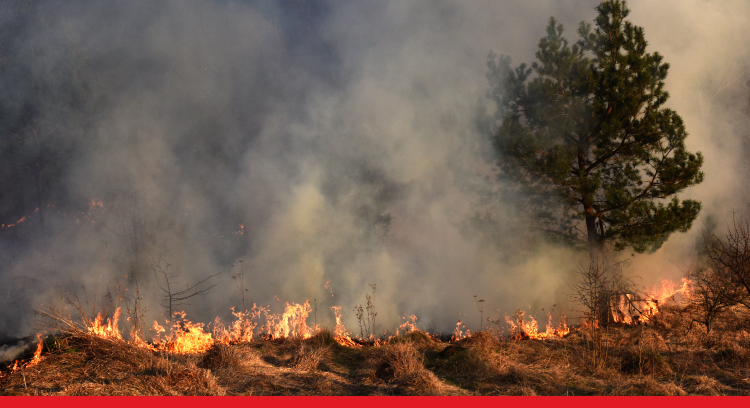Artificial Intelligence Tech Takes on Wildfires | October 2023
AI-powered tech is a growing resource for some of society’s most important challenges.

The applications of artificial intelligence (AI) have multiplied dramatically across a variety of industries. Although the use of AI is often controversial due to ethical concerns, AI-powered tech is a growing resource for some of society’s most important challenges. For example, fire services have deployed AI to fight wildfires.
Wildfires on the Rise
Around the world, climate change has contributed to an increasing number of wildfires that tend to become larger and more intense. Record-breaking fires have been seen in Hawaii, Canada, Chile, and the Mediterranean, among other areas, and the problem is expected to become worse as the Earth’s temperature rises. The risks are exacerbated by human-built infrastructure (e.g., power lines). This phenomenon has fueled demand for technology that addresses this problem.
AI Fights Fires
Pano AI is a software developer that created a wildfire management platform. Panoramic cameras mounted on cell towers capture visuals of their surroundings while AI algorithms analyze the images to detect signs of fires. Organizations, such as utility companies, fire departments, and ski resorts, can pay a subscription fee to Pano AI to gain access to data collected by its fire lookout cameras.
In the past, fires have been spotted by commercial pilots passing by, people in manned lookout towers, teams of people reviewing traditional cameras, or bystanders and local residents. According to one fire chief, conventional methods can take hours or days to spot flames while AI-powered technology can detect a threat immediately, improving response times and preventing small, manageable fires from ever spreading. Pano AI has more than two dozen customers in six states plus Australia that subscribe to its fire-detection service. The company’s current footprint is around 9 million acres of land.
Pano AI is not the only company using technology to aid in wildfire management. Wildfire technology is a relatively new and rapidly developing segment of the tech industry. Wildfire tech was almost non-existent just five years ago, but now several hundred companies have recognized the immense business opportunity and have entered the sector. The technology isn’t limited to AI cameras: there are satellites, thermal imaging sensors, fire-fighting robots, and drones with infrared cameras that fly at night. While satellites have been used for wildfire tracking since the 1970s, today’s tech is significantly more advanced.
Limitations
Wildfire tech has not been widely adopted for several reasons. First, it’s relatively new and hasn’t had time to spread. Companies such as Pano AI need many more cameras in place, but it will take time and money to improve the infrastructure. Second, many people are skeptical about the technology, so it can be difficult to win over key decision-makers.
Third, there are still limitations to the technology itself. For instance, satellite images are delivered with a delay, and cameras may not perform well at night. After the 2018 Camp Fire, the deadliest wildfire in the United States until recently, the United States military began sharing data from a classified network of spy satellites, drones, and other aircraft. Since the data comes from a classified network, it must be cleaned first, creating a 10 to 12-minute delay. And lastly, the technology is expensive, making it unaffordable for some organizations who would benefit from having access.
There are many ethical issues relating to AI, including privacy, job loss, and more. Many people fear AI will lead to widespread job loss while others say AI will lead to job creation. As is the case in most AI applications, AI firefighting tech won’t completely replace humans in wildfire management but rather supplement human intelligence. For instance, Pano AI’s algorithms have difficulty telling the difference between smoke and fog, so a human is necessary to confirm fire alerts. Humans are also required to train AI programs.
Plus, AI has the power to make dangerous professions such as firefighting significantly safer. In this particular application, some would say the benefits outweigh the risks.
In the Classroom
This article can be used to discuss environmental protection (Chapter 2: Business Ethics and Social Responsibility).
Discussion Questions
What are some of the benefits of using AI to fight wildfires?
Describe some of the ethical concerns related to AI.
Explain some of the limitations of wildfire management tech.
This article was developed with the support of Kelsey Reddick for and under the direction of O.C. Ferrell, Linda Ferrell, and Geoff Hirt.
Sources
Coco Liu, "AI, Robots and Satellite Sensors Are Helping in the Fight Against Wildfires," Bloomberg, September 25, 2023, https://www.bloomberg.com/news/articles/2023-09-25/wildfire-tech-startups-in-france-california-and-germany-help-firefighters
Kelvin Chan, "As the Threat of Wildfires Rises, Groups Tasked with Fighting Them Turn to AI for Help," PBS, September 24, 2023, https://www.pbs.org/newshour/science/as-the-threat-of-wildfires-rises-groups-tasked-with-fighting-them-turn-to-ai-for-help
Thomas Fuller, "Can A.I. Detect Wildfires Faster Than Humans? California Is Trying to Find Out." The New York Times, August 24, 2023, https://www.nytimes.com/2023/08/24/us/wildfires-ai-detection-california.html



